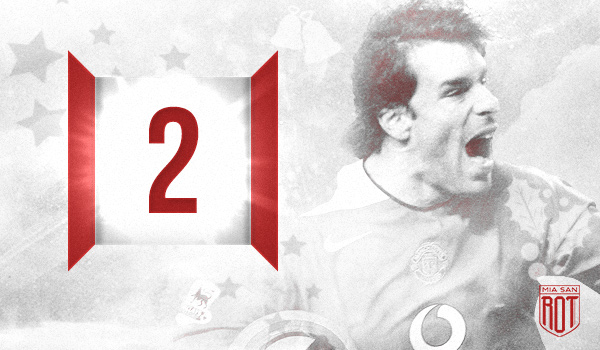The MSR advent calendar: Our favorite signings that never happened: Door 2 – Ruud van Nistelrooy
The situation with the player
In a time long before DAZN, I used to watch Eurogoals in the afternoon after school, the highlight show of the weekend’s best games on the continent. One player stood out for me like no other: A long-haired giant in a red jersey, who managed to combine the finesse of a Raul with the physicality and assertiveness of a Christian Vieri like no other player at that time. His goals were characterised by a remarkable combination of delicate ease and firm robustness. Against the tough English defenders, he had to be as fierce as Nikolai Valuyev one second, and then sting like Muhammad Ali the next. In addition, his ability to score with both feet and his strong aerial game made him almost unstoppable.
Rutgerus Johannes Martinus – or Ruud for short – van Nistelrooy moved to the Theatre of Dreams in 2001 with the recommendation of 75 goals and 24 assists in only 98 games at PSV in the Eredivisie. At Manchester he matured into a world-class striker playing alongside such greats as David Beckham, Ryan Giggs and Paul Scholes. In the Premier League he scored 95 goals in 150 games and with Thierry he was engaged a permanent contest for the title of the league’s most lethal striker.
Today, van Nistelrooy sits sixth in the all-time goal scoring charts of the Champions League with 56 goals, with the second best goals per 90 rate ever after Lionel Messi (0.77 goals per game).
The situation at Bayern
Looking back, it is almost surprising that FC Bayern was so close to signing the Dutchman. Although the Bayern team under Felix Magath had won the domestic double twice in a row, with respect to the Champions League the mid-2000s can only go down in club history as a time of one lemon after another. Against Real Madrid, Chelsea and the “damned” AC Milan, they never got further than the quarter-finals in three consecutive years. In the 2005/06 season they were even eliminated the round of sixteen in a 1-4 thrashing of perhaps the best Milan team in recent history.
In addition, the team lost the Capitano after the World Cup at home in 2006. The undisputed star of the team, Michael Ballack, had switched to Chelsea FC after a protracted farce about his contract extension. The team was on its last legs.
The situation in the hypothetical team
After the departure of Ballack, the then 30-year-old van Nistelrooy could have seemlessly taken over the mantle of the team’s biggest world star. Other signings in the post World Cup summer were Podolski, van Buyten and van Bommel. They were all strong additions to the squad. In the team van Nistelrooy would have had to fight with Makaay, Pizarro and the young Poldi for the places in attack. Here, Magath would probably have had the two Dutchmen act as double point men in his 4-4-2 system, with Pizarro as the super sub and Podolski playing out wide.

(Image: Adrian Dennis/AFP via Getty Images)
The starting eleven in that season could have looked like this: Kahn – Lahm, Lucio, van Buyten, Sagnol – Hargreaves, van Bommel, Schweinsteiger, Podolski – van Nistelrooy, Makaay. With Demichelis, Salihamidzic, Scholl and Pizarro, Magath would even have had some options to throw in from the bench.
The ‘what if ‘ outlook
It is hard to believe that the 2006/07 season would have taken the same bitter course with the Dutchman in the team: Only fourth in the league, the DFB-Pokal exit against Aachen before Christmas and, in Europe, Milan as the insurmountable barrier once again. One of the reasons for this was the situation in the center forward position, as Makaay and Pizarro combined scored only 30 goals in all competitions. In five matches in the league, FC Bayern even failed to score altogether.
With his class, van the Man could have scored the goals that would have given Bayern the ten missing points for the title. In the Primera Division he became top scorer in his first season for Real Madrid, the team whose offer he said he could not refuse, with 25 goals in 2006/07. A striker of this quality simply did not exist in the Bundesliga at that time. Whether having him in the team would have been enough for Bayern to get past Milan in the Champions League will of course remain unknown forever.
More interesting, however, are the effects on the summer after. Magath was sacked in the disappointing following season and it was again Ottmar Hitzfeld who took over. For the new season, almost €100m were invested and with Franck Ribéry the cornerstone of the success of the 2010s joined the club, while at the same time many old and deserving players were let go. It is questionable whether the club would have opted for such a radical makeover after a potential third double in a row. The necessary rejuvenation with a lot of fresh blood in many positions would not have taken place or been postponed. The single upside: Perhaps we fans would have been spared nine months of Jürgen Klinsmann.









